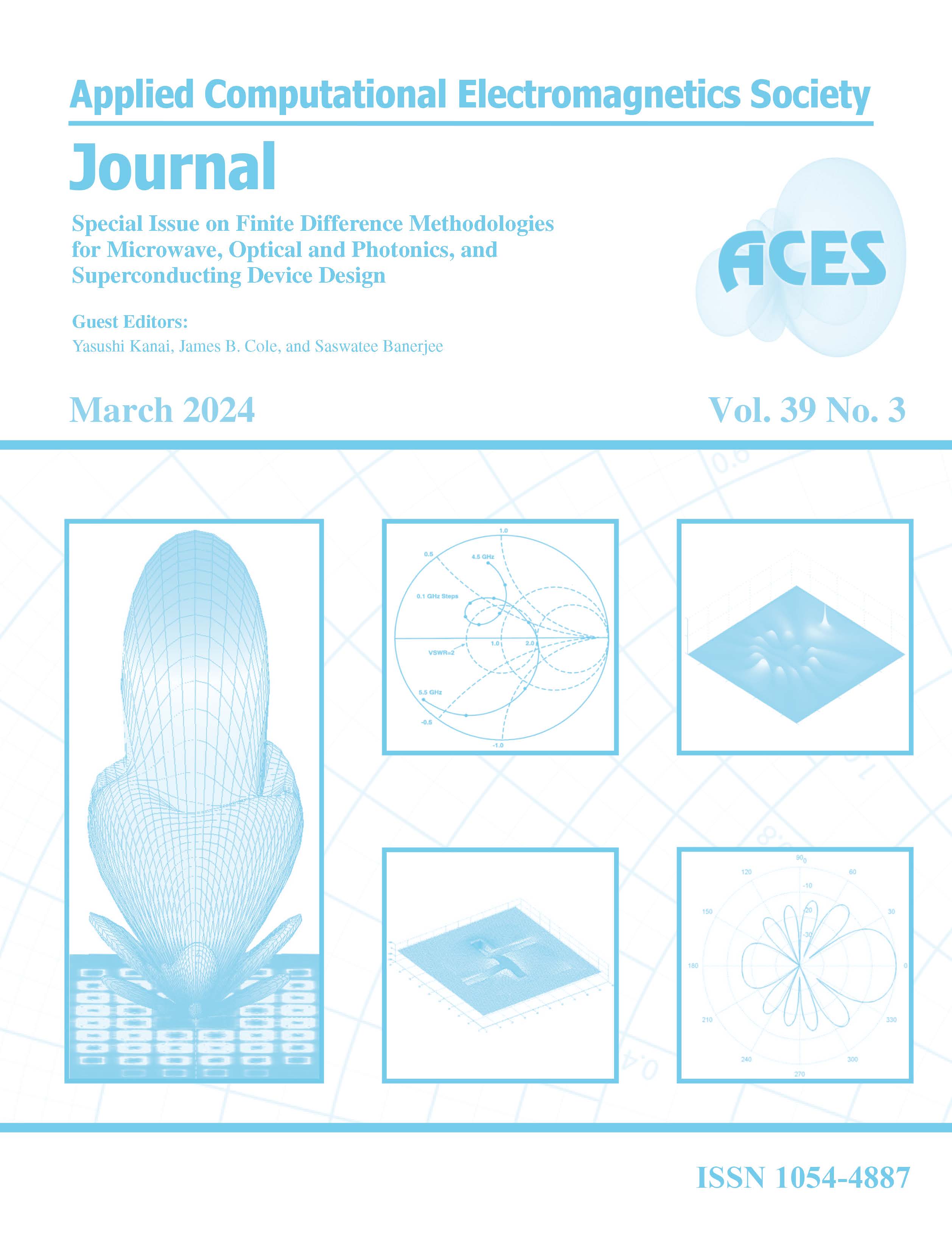A Path Integral Representation Model to Extend the Analytical Capability of the Nonstandard Finite-difference Time-domain Method
DOI:
https://doi.org/10.13052/2024.ACES.J.390304Keywords:
Computational electromagnetics, finite-difference time-domain methods, integral equations, radar cross sectionAbstract
The nonstandard finite-difference time-domain (NS-FDTD) method is a powerful tool for solving Maxwell’s equations in their differential form on orthogonal grids. Nonetheless, to precisely treat arbitrarily shaped objects, very fine lattices should be employed, which often lead to unduly computational requirements. Evidently, such an issue hinders the applicability of the technique in realistic problems. For its alleviation, a new path integral (PI) representation model, equivalent to the NS-FDTD concept, is introduced. The proposed model uses a pair of basic and complementary path integrals for the H-nodes. To guarantee the same accuracy and stability as the NS-FDTD method, the two path integrals are combined via optimization parameters, derived from the corresponding NS-FDTD formulae. Since in the PI model, E-field computations on the complementary path are not necessary, the complexity is greatly reduced. Numerical results from various real-world problems prove that the proposed method improves notably the efficiency of the NS-FDTD scheme, even on coarse orthogonal meshes.
Downloads
References
J. B. Cole, “A high accuracy FDTD algorithm to solve microwave propagation and scattering problems on a coarse grid,” IEEE Trans. Microw. Theory Tech., vol. 43, no. 9, pp. 2053–2058, 1995.
J. B. Cole, “A high-accuracy realization of the Yee algorithm using non-standard finite differences,” IEEE Trans. Microw. Theory Tech., vol. 45, no. 6, pp. 991–996, 1997.
J. B. Cole, “High-accuracy Yee algorithm based on nonstandard finite differences: New developments and verifications,” IEEE Trans. Antennas Propag., vol. 50, no. 9, pp. 1185–1191, 2002.
J. B. Cole, “High-accuracy FDTD solution of the absorbing wave equation, and conducting Maxwell’s equations based on a nonstandard finite-difference model,” IEEE Trans. Antennas Propag., vol. 52, no. 3, pp. 725–729, 2004.
K. Taguchi, T. Ohtani, T. Kashiwa, and Y. Kanai, “Characteristics of evanescent waves in the nonstandard FDTD method,” IEEE Trans. Magn., vol. 43, no. 4, pp. 1313–1316, 2007.
T. Ohtani, K. Taguchi, T. Kashiwa, Y. Kanai, and J. B. Cole, “Nonstandard FDTD method for wideband analysis,” IEEE Trans. Antennas Propag., vol. 57, no. 8, pp. 2386–2396, 2009.
T. Ohtani and Y. Kanai, “Coefficients of finite difference operator for rectangular cell NS-FDTD method,” IEEE Trans. Antennas Propag., vol. 59, no. 1, pp. 206–213, 2011.
N. Okada and J. B. Cole, “Nonstandard finite difference time domain algorithm for Berenger’s perfectly matched layer,” Applied Computational Electromagnetics Society (ACES) Journal, vol. 26, no. 2, pp. 153–159, 2011.
T. Ohtani and Y. Kanai, “Characteristics of boundary model in the 2-D NS-FDTD method,” IEEE Trans. Magn., vol. 48, no. 2, pp. 191–194,2012.
J. B. Cole and N. Okada, “High accuracy models for source terms in the nonstandard FDTD algorithm,” in Proc. Int. Symp. Electromagn. Theory, art. no. 24PM2C-01, pp. 1098–1100, 2013.
T. Ohtani, Y. Kanai, and N. V. Kantartzis, “A 4-D subgrid scheme for the NS-FDTD technique using the CNS-FDTD algorithm with the Shepard method and a Gaussian smoothing filter,” IEEE Trans. Magn., vol. 51, no. 3, art. no. 7201004, 2015.
T. Ohtani and Y. Kanai, “An enhanced Total-field/Scattered-field scheme for the 3-D nonstandard finite-difference time-domain method,” IEEE Trans. Magn., vol. 52, no. 3, art. no. 7204705,2016.
J. B. Cole and S. Banerjee, Computing the Flow of Light: Nonstandard FDTD Methodologies for Photonics Designs. Bellingam, WA: SPIE Press,2017.
J. Jose, S. K. Simon, J. Kizhakooden, J. Andrews, and V. P. Joseph, “Nonstandard FDTD realization of radiation behaviour of epsilon negative metamaterial corner reflector antenna,” in Proc. IEEE 13th
Int. Congr. Artif. Mat. Novel Wave Phenom.-Metamat., pp. 178–180, Rome, Italy, 2019.
J. B. Cole, R. Katouf, and S. Banerjee, “Nonstandard finite difference time domain methodology for harmonics generation in nonlinear dielectrics,” in Proc. 2021 Int. Appl. Comput. Electromagn. Soc. Symp., Online, 2021.
A. Taflove and S. Hagness, Computational Electrodynamics: The Finite- Difference Time-Domain Method. 3rd Edition, Chs. 7, 8, 10, and 14. Norwood, MA: Artech House, 2005.
A. Taflove, Advances in Computational Electrodynamics: The Finite-Difference Time-Domain Method. Norwood, MA: Artech House, 1998.
D. M. Sullivan, Electromagnetic Simulation Using the FDTD Method. New York: IEEE Press, 2000.
K. S. Kunz and R. J. Luebbers, The Finite Difference Time Domain Method for Electromagnetics. Ch. 13, New York: CRC Press, 1993.
C. J. Railton, I. J. Craddock, and J. B. Schneider, “The analysis of general two-dimensional PEC structures using a modified CPFDTD algorithm,” IEEE Trans. Microw. Theory Tech., vol. 44, no. 10, pp. 1728–1733, 1996.
S. Dey and R. Mittra, “A locally conformal finite-difference time-domain (FDTD) algorithm for modeling three-dimensional perfectly conducting objects,” IEEE Microw. Guided Wave Lett., vol. 7, no. 9, pp. 273–275, 1997.
T. Ohtani, Y. Kanai, and N. V. Kantartzis, “A rigorous path integral scheme for the two-dimensional nonstandard finite-difference time-domain method,” in Proc. COMPUMAG 2019, art. no. PA-M4–9, Paris, France, 2019.
T. Ohtani, Y. Kanai, and N. V. Kantartzis, “A nonstandard path integral model for curved surface analysis,” Energies, vol. 15, art. no. 4322, 2022.
T. Ohtani, Y. Kanai, and N. V. Kantartzis, “An integral representation model for the nonstandard finite-difference time-domain scheme,” in Proc. COMPUMAG 2021, art. no. OD1–4, Online,2022.
S. Watanabe and M. Taki, “An improved FDTD model for the feeding gap of a thin-wire antenna,” IEEE Microwave Guided Wave Lett, vol. 8, no. 4, pp. 152–154, 1998.
R. M. Makinen, J. S. Juntunen, and M. A. Kivikoski, “An improved thin-wire model for FDTD,” IEEE Trans. Microw. Theory Tech., vol. 50, no. 5, pp. 1245–1255, 2002.
NEC: Numerical Electromagnetics Code, Available online: https://www.nec2.org/
J. J. H. Wang, Generalized Moment Methods in Electromagnetics: Formulation and Computer Solution of Integral Equations. John Wiley & Sons: USA, 1991.




